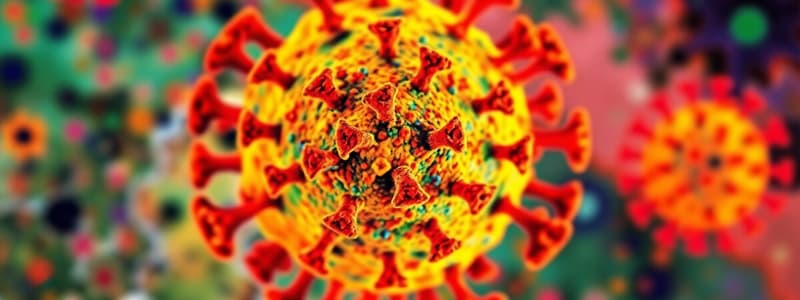Podcast
Questions and Answers
What technique is used to amplify viral DNA for analysis?
What technique is used to amplify viral DNA for analysis?
- Real-time PCR (correct)
- Western blotting
- Southern blotting
- Gel electrophoresis
Which method allows for the conversion of viral RNA to cDNA before amplification?
Which method allows for the conversion of viral RNA to cDNA before amplification?
- Hybridization techniques
- Sanger sequencing
- Reverse transcriptase PCR (correct)
- Elisa testing
What is a primary purpose of using fluorescent dyes in real-time PCR?
What is a primary purpose of using fluorescent dyes in real-time PCR?
- To monitor gene amplification during the process (correct)
- To enhance the visibility of virus antigens
- To facilitate gel electrophoresis
- To calculate molecular weights
What does Western blotting primarily detect?
What does Western blotting primarily detect?
Which analysis technique compares amplified viral gene sequences to a database?
Which analysis technique compares amplified viral gene sequences to a database?
What is the primary technique used to observe the structure of a virion?
What is the primary technique used to observe the structure of a virion?
Which cell lines are commonly used for animal cell culture in virus detection?
Which cell lines are commonly used for animal cell culture in virus detection?
What is the function of confocal (fluorescent) light microscopy in virology?
What is the function of confocal (fluorescent) light microscopy in virology?
Which method is NOT used to isolate pure virus particles from infected cells?
Which method is NOT used to isolate pure virus particles from infected cells?
What is a common outcome observed in cells infected by certain viruses like Nipah and measles?
What is a common outcome observed in cells infected by certain viruses like Nipah and measles?
What is the main reason for using X-ray crystallography in viral diagnostics?
What is the main reason for using X-ray crystallography in viral diagnostics?
What is the purpose of performing plaque assays?
What is the purpose of performing plaque assays?
Which of the following instruments allows for the analysis of three-dimensional structures of viruses?
Which of the following instruments allows for the analysis of three-dimensional structures of viruses?
Flashcards
Electron Microscopy
Electron Microscopy
A technique used to visualize the structure of viruses and virus-infected cells, by staining samples with chemicals (like potassium phosphotungstate or ammonium molybdate).
X-ray Crystallography
X-ray Crystallography
A method to determine the arrangement of atoms and molecules in a virus crystal, formed after dehydrating and condensing virus samples.
Cryo-electron Microscopy
Cryo-electron Microscopy
A technique for creating 3D images of frozen virus structures using computer analysis.
Animal Cell Culture
Animal Cell Culture
Signup and view all the flashcards
Cytopathic Effects (CPEs)
Cytopathic Effects (CPEs)
Signup and view all the flashcards
Confocal Microscopy
Confocal Microscopy
Signup and view all the flashcards
Virus Infection Models
Virus Infection Models
Signup and view all the flashcards
Embryonated Eggs
Embryonated Eggs
Signup and view all the flashcards
Plaque Assay
Plaque Assay
Signup and view all the flashcards
Plaque Purification
Plaque Purification
Signup and view all the flashcards
Laboratory Strain
Laboratory Strain
Signup and view all the flashcards
Hybridization
Hybridization
Signup and view all the flashcards
Southern Blotting
Southern Blotting
Signup and view all the flashcards
Northern Blotting
Northern Blotting
Signup and view all the flashcards
PCR (Polymerase Chain Reaction)
PCR (Polymerase Chain Reaction)
Signup and view all the flashcards
RT-PCR (Reverse Transcriptase PCR)
RT-PCR (Reverse Transcriptase PCR)
Signup and view all the flashcards
Real-time PCR
Real-time PCR
Signup and view all the flashcards
Genome Sequencing
Genome Sequencing
Signup and view all the flashcards
Sanger sequencing
Sanger sequencing
Signup and view all the flashcards
Next-Generation Sequencing (NGS)
Next-Generation Sequencing (NGS)
Signup and view all the flashcards
Western blotting
Western blotting
Signup and view all the flashcards
ELISA (Enzyme-linked Immunosorbent Assay)
ELISA (Enzyme-linked Immunosorbent Assay)
Signup and view all the flashcards
Study Notes
Virological Diagnostics
- Learning Outcomes: Students will be able to apply viral structural analysis, analyze virally infected cells, and apply molecular virological diagnostics for detecting virus infections.
Part 1: Observation of Viral Structures
- Structural Investigation Tools: Electron microscopy is used to investigate viral structure and virus-infected cells.
- Samples are stained with potassium phosphotungstate or ammonium molybdate.
- This allows estimation of viral shape and size.
- Electron microscopy uses an electron beam.
- X-ray Crystallography: Virions are condensed and dehydrated into crystals, allowing study of their molecules and atoms using X-rays.
- Cryo-electron Microscopy: Three-dimensional (3D) images of frozen virus structures are analyzed using computer software.
Cultivation and Isolation of Viruses
- Animal Cell Culture: Animal cell culture (e.g., Vero, MDCK, HepG2, Calu-3, A549) is used to cultivate viruses from samples.
- Cytopathic Effects (CPEs): Inverted light microscopy observes effects of virus infections in host cells, including cytopathic effects (e.g., cell shrinking and rounding up).
- Multinucleated Giant Cells (Syncytia): Some viruses cause multinucleated giant cells (e.g., Nipah, measles, parainfluenza virus).
- Cellular Functions: CPEs are signs of cell damage and loss of normal cellular functions.
Confocal Microscopy
- Confocal microscopy uses fluorescently tagged antibodies that bind to virus antigens in infected cells (nucleus, cytoplasm, or membranes).
Virus Infection Models
- Laboratory Animals: Nonhuman primates and mice are used as virus infection models.
- Embryonated Eggs: Embryonated eggs are used for virus cultivation, particularly for vaccine production (e.g., herpes, varicella-zoster, influenza).
- Tissue Culture: Viruses can be cultivated into tissue culture.
Isolation and Purification of Viruses
- Plaque Assay: Plaques form in areas where cells are infected and killed by viruses.
- Virus Isolation: Virus particles are isolated from plaque centers.
- Plaque Purification: Isolated virus particles are inoculated onto monolayer cells for amplification.
- Laboratory Strain Development: Viruses that replicate poorly in a lab can be 'passaged' (cultured) to increase replication in lab environments.
Part 2: Molecular Diagnostics for Virus Infections
- A. Detection of Virus Nucleic Acids:
- Hybridization (Southern or Northern blotting) uses specific nucleic acid probes that bind to complementary virus genes using labeled probes.
- B. Detection of Virus Antigens: -Western blotting detects virus-specific antibodies or antigens with labeled antibodies.
Polymerase Chain Reaction (PCR)
- Amplifies specific virus genes using oligonucleotide primers.
- Converts viral RNA to cDNA using reverse transcriptase for RNA viruses, then amplified using PCR.
- Amplified genes are separated by agarose gel electrophoresis and stained for analysis.
Real-Time PCR
- Real-time PCR quantifies viral gene copies in a sample using fluorescent dyes (e.g., SyberGreen).
- Monitors gene amplification in real-time.
- Higher viral load correlates to faster fluorescent signal.
Genome Sequencing
- Sanger and Next-Generation Sequencing: Amplified viral genes/whole genomes are sequenced using these methods.
- Sequence similarity is compared to databases (e.g., BLAST).
- Virus strains, open reading frames, promoters, and enhancers are identified.
- Phylogenetic trees can be constructed.
Enzyme-linked Immunosorbent Assay (ELISA)
- Detects virus particles, proteins, or antigens using microplates, virus-specific antibodies, and high sensitivity.
Studying That Suits You
Use AI to generate personalized quizzes and flashcards to suit your learning preferences.




